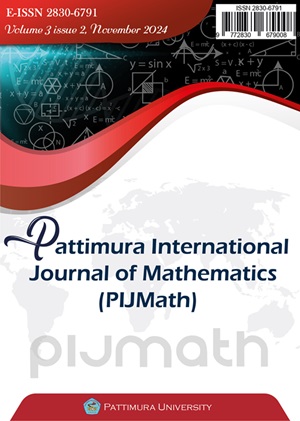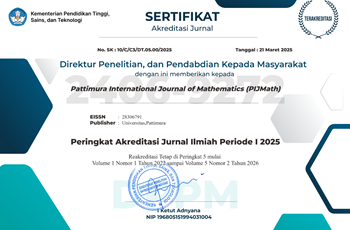Wind Speed Category Characteristics in Bone Bolango Regency: A Markov Chain Approach Using the Beaufort Scale and Metropolis-Hastings Algorithm
Abstract
This study models daily wind speed transitions in the Bone Bolango Regency using the Markov Chain Monte Carlo (MCMC) method and the Metropolis-Hastings algorithm, employing the Beaufort scale for wind speed classification. The research aims to predict the steady-state distribution of wind speeds and evaluate their temporal stability. Daily wind speed data from 2023, provided by the Meteorology, Climatology, and Geophysics Agency (BMKG), were categorized into three levels: calm, light breeze, and fresh breeze, based on the Beaufort scale. Transition probabilities were estimated using the Beta distribution, and simulations via the Metropolis-Hastings algorithm yielded the steady-state distribution. Results show a significant tendency for transitions from calm and light breeze categories to fresh breezes, with varying probabilities. Notably, calm conditions exhibit a 69% likelihood of transitioning to a light breeze. This research contributes to improving wind speed prediction models by integrating statistical algorithms with meteorological classifications. The findings have implications for enhancing short-term weather forecasts and developing predictive systems for regions with similar weather patterns.Downloads
References
M. Abdy and W. Sanusi, “Karakteristik Kategori Kecepatan Angin di Kota Majene dengan Pendekatan Rantai Markov,” SAINTIFIK, vol. 6, no. 1, Jan. 2020, doi: 10.31605/saintifik.v6i1.305.
S. K. Nasib, N. Nurwan, E. D. D. Yanuari, and T. Macmud, “Karakteristik Rantai Markov pada Data Curah Hujan Bulanan Stasiun Djalaluddin,” JMPM: Jurnal Matematika dan Pendidikan Matematika, vol. 7, no. 2, pp. 81–89, Sep. 2022, doi: 10.26594/jmpm.v7i2.2654.
D. C. R Novitasari et al., “Analisis Kecepatan Angin pada Pasang Surut Air Laut dengan Menggunakan Algoritma Forward-Backward dalam Hidden Markov Model di Wilayah Pelabuhan Tanjung Perak Surabaya,” Jurnal Sains Matematika dan Statistika, vol. 4, no. 1, 2018.
S. K. Sim, P. Maass, and P. G. Lind, “Wind speed modeling by nested ARIMA processes,” Energies (Basel), vol. 12, no. 1, Jan. 2019, doi: 10.3390/en12010069.
S. Karatepe and K. W. Corscadden, “Wind Speed Estimation: Incorporating Seasonal Data Using Markov Chain Models,” ISRN Renewable Energy, vol. 2013, pp. 1–9, Dec. 2013, doi: 10.1155/2013/657437.
W. Sanusi, A. A. Jemain, W. Z. W. Zin, and M. Zahari, “The Drought Characteristics Using the First-Order Homogeneous Markov Chain of Monthly Rainfall Data in Peninsular Malaysia,” Water Resources Management, vol. 29, no. 5, pp. 1523–1539, Mar. 2015, doi: 10.1007/s11269-014-0892-8.
A. A. Paulo and L. S. Pereira, “Prediction of SPI drought class transitions using Markov chains,” Water Resources Management, vol. 21, no. 10, pp. 1813–1827, Oct. 2007, doi: 10.1007/s11269-006-9129-9.
A. A. Paulo, E. Ferreira, C. Coelho, and L. S. Pereira, “Drought class transition analysis through Markov and Loglinear models, an approach to early warning,” in Agricultural Water Management, Aug. 2005, pp. 59–81. doi: 10.1016/j.agwat.2004.09.039.
H. Harizahayu, “PEMODELAN RANTAI MARKOV MENGGUNAKAN ALGORITMA METROPOLIS-HASTINGS,” MAp (Mathematics and Applications) Journal, vol. 2, no. 2, pp. 11–18, Dec. 2020, doi: 10.15548/map.v2i2.2259.
Copyright (c) 2025 Saiful Pomahiya, Nurwan Nurwan, Nisky Imansyah Yahya, Salmun K. Nasib, Isran K. Hasan, Asriadi Asriadi

This work is licensed under a Creative Commons Attribution-NonCommercial 4.0 International License.
The author(s) hold the copyright of the published article without restriction. This policy means that the journal allows the author(s) to hold and retain publishing rights without restrictions.
The author(s) holds the copyright of published articles without limitation. This policy means that the journal allows the author to hold and retain publishing rights without restrictions. Journal editors are given the copyright to publish articles in according to agreement signed by the author and also include statement of originality of the article


.jpg)












 This work is licensed under a
This work is licensed under a 